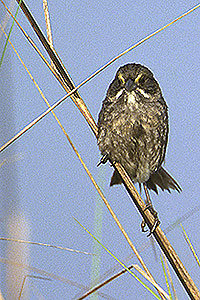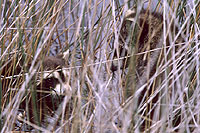|
History Animals & Plants Natural Communities Coastal Dry Uplands Upland Mesic Freshwater Marshes Forested Wetlands Fresh Water Estuaries |
Natural Communities and Habitats:
Introduction
 The seaside sparrow is a real habitat specialist. This species lives only in salt marshes. (photo by Karla Brandt) |
The answers lie in what each species requires to survive. Some species of plant and animal need a very specific set of resources to make their living. These are the specialists. Other species can thrive in a wide variety of habitats. These are the generalists.
You can study these habitat needs by focusing on each species, one by one, and figuring out what that particular plant or animal needs to survive. Another way is to look at groups of plants and animals that tend to be found together. These are natural communities.
Creating categories to distinguish among natural communities is a complicated business. Where do you start? You could divide everything between salt water and fresh water, or between communities that have trees and those that don't, or between those where cabbage palms grow and those where they don't. Then you have to decide where to stop, what level of detail you want to include.
Although we humans like to organize things into tidy and clearly separated compartments, nature doesn't always lend itself to this way of thinking. Put your mind's eye in an airplane and fly north from the Gulf of Mexico to the Florida/Georgia line. You'll see a transition from deep water to shallower offshore waters to very shallow near-shore waters and bays, grading into salt marshes or river mouths or barrier islands and beaches, and then a mosaic of pinelands, marshes, and swamps. The clearest boundaries you're likely to see are those separating human communities such as towns, farmlands, and pine plantations from natural ones. Your eye is attracted most by lines of contrast, but it's the subtle transition of one natural community to the next that makes classifying such communities so challenging.
 Raccoons are also found in salt marshes--and in just about every other kind of habitat in Florida. They thrive in cities and suburbs, too. (photo by Karla Brandt) |
For this website, we are using a system created by the Florida Freshwater Fish and Wildlife Conservation Commission (FWC). Using satellite images taken in 2003, the FWC mapped the entire state, ending up with 43 categories: 26 natural and semi-natural vegetation types, 16 types of disturbed lands (e.g., agriculture, urban, mining), and 1 category for open water. Of the 43 categories, 28 are found in the seven counties in the ARROW region: 19 natural and semi-natural vegetation types, 8 kinds of disturbed lands, and open water. In the following pages you'll find descriptions of those types.
|
Community Type
Coastal Strand |
Calhoun
|
Franklin
x |
Gadsden
|
Gulf
x |
Jackson
|
Liberty
|
Wakulla
|
Note: The content of the website has not been updated since 2005. The site remains online for it's value as legacy content and is unlikely to be updated.